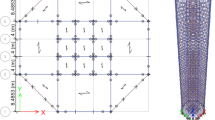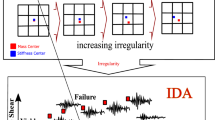Abstract
Floor diaphragms are structural elements mainly responsible for transmitting lateral loads to the adjoining vertical members of the Seismic-Force-Resisting System (SFRS). Under significant seismic events, the actual in-plane stiffness of floor diaphragms affects patterns of load distribution in-between horizontal and vertical elements and, as such, contributes to the local nonlinear response and the global dynamic behavior. However, in SFRS with mass timber and hybrid timber-based floor diaphragms, neither design provisions nor procedures exist to account for its in-plane flexibility. To highlight the influence of the actual in-plane stiffness of diaphragms on a timber-steel hybrid building system, this paper analyzes its dynamic response via nonlinear dynamic analysis. The OpenSees framework is adopted to develop three finite-element building models that feature diaphragms with (i) rigid behavior, (ii) actual members and connections diaphragm subassembly behavior, including panel-to-panel slab connections, or (iii) neglecting the contribution of the slab connections, respectively. The SFRS of the building entails a Special Concentrically Braced Frame whose nonlinear behaviors are explicitly simulated, including global buckling, tensile yielding, and post-buckling behaviors. The collapse fragility analysis reveals that the conditional probability of exceeding all three considered limit states given any level of ground motion intensity for the SFRS equipped with the CLT-steel floor diaphragm is close to that of the SFRS with rigid diaphragm behavior. Removal of CLT panel-to-panel connections attracts disproportionate and excessive lateral deformation demands towards the unbraced frames due to the increased in-plane diaphragm flexibility.
















Similar content being viewed by others
Data availability
The numerical simulation dataset and details of the three-dimensional finite element model are listed in the submitted manuscript.
References
Applied Technology Council (2020) Short-Period Building Collapse Performance and Recommendations for Improving Seismic Design. 4(October)
ASCE (2000) American Society of Civil Engineers, FEMA 356 Prestandard and Commentary for the Seismic Rehabilitation of Building. Rehabilitation (November).
Ballio G, Castiglioni CA (1995) A unified approach for the design of steel structures under low and/or high cycle fatigue. J Constr Steel Res 34(1):75–101. https://doi.org/10.1016/0143-974X(95)97297-B
Barber D, Blount D, Hand JJ, Roelofs M, Wingo L, Woodson J, Yang F (2022) Design guide 37: hybrid steel frames with wood floors. AISC, Chicago
Beairsto C, Gupta R, Miller TH (2022) Monotonic and cyclic behavior of CLT diaphragms. Pract Period Struct Des Constr 27(2):1–14. https://doi.org/10.1061/(asce)sc.1943-5576.0000658
Bezabeh MA, Tesfamariam S, Popovski M et al (2017) Seismic base shear modification factors for timber-steel hybrid structure: collapse risk assessment approach. J Struct Eng (united States). https://doi.org/10.1061/(ASCE)ST.1943-541X.0001869
Black G, Wenger WAB, Popov EP (1980) Inelastic Buckling of Steel Struts Under Cyclic Load Reversals. Berkeley
Brown JR, Li M, Palermo A et al (2022) Experimental testing and analytical modelling of single and double post-tensioned CLT shear walls. Eng Struct 256(November 2021):114065. https://doi.org/10.1016/j.engstruct.2022.114065
Chen C-H (2010) Performance-Based Seismic Demand Assessment of Concentrically Braced Steel Frame Buildings - ProQuest. University of California, Berkeley. Available at: https://www.proquest.com/openview/76882c7eded4ff2080b0f2ef1a1d94c4/1?pq-origsite=gscholar&cbl=18750&casa_token=Xe7buubYj9sAAAAA:rqGhsdFr98OfwU5SkWxx064rdMreZAe01SYcanJ2eVyOPrjzFOPjy4m914IYoYKuIaciIEaZPg (accessed 8 August 2022).
D’Arenzo G, Casagrande D, Reynolds T et al (2019) In-plane elastic flexibility of cross laminated timber floor diaphragms. Constr Build Mater 209:709–724. https://doi.org/10.1016/j.conbuildmat.2019.03.060
Digital Research Alliance of Canada (2022). Available at: https://docs.alliancecan.ca/wiki/Technical_documentation (accessed 3 October 2022)
Dovetail (2020) Europeans in the Lead. Available at: http://www.wooddesignandbuilding.com/europeans-in-the-lead/ (accessed 26 July 2022)
ETA (2019) Stora Enso European Technical Assessment ETA-11/0030. Stat Field Theor 53(9):1689–1699
Eurocode C (2004) 8: Design of structures for earthquake resistance—Part 1: General rules, seismic actions and rules for buildings (EN 1998–1: 2004). European Committee for Normalization, Brussels
Gómez CAA (2006) Seismic hazard map for the Italian territory using Macroseismic data. Earth Sci Res J 10(2):67–90
Guidoboni E, Ferrari G, Mariotti D et al (2007) Catalogue of Strong Earthquakes in Italy (461 B.C.-1997) and Mediterranean Area (760 B.C.-1500). (December 2016)
Gutkowski R, Brown K, Shigidi A et al (2008) Laboratory tests of composite wood-concrete beams. Constr Build Mater. https://doi.org/10.1016/j.conbuildmat.2007.03.013
Hassanieh A, Valipour HR, Bradford MA (2016) Experimental and numerical study of steel-timber composite (STC) beams. J Constr Steel Res 122:367–378. https://doi.org/10.1016/j.jcsr.2016.04.005
Hsiao PC, Lehman DE, Roeder CW (2012) Improved analytical model for special concentrically braced frames. J Constr Steel Res 73:80–94. https://doi.org/10.1016/j.jcsr.2012.01.010
Hu Q, Gao Y, Meng X et al (2020) Axial compression of steel–timber composite column consisting of H-shaped steel and glulam. Eng Struct 216:110561. https://doi.org/10.1016/j.engstruct.2020.110561
Humar J, Popovski M (2013) Seismic response of single-storey buildings with flexible diaphragms. Can J Civ Eng 40(9):875–886. https://doi.org/10.1139/cjce-2012-0493
Iervolino I, Galasso C, Cosenza E (2010) REXEL: computer aided record selection for code-based seismic structural analysis. Bull Earthq Eng. https://doi.org/10.1007/s10518-009-9146-1
Italian Ministry of Infrastructure and Transport (2009) Istruzioni per l’applicazione delle «Nuove norme tecniche per le costruzioni» di cui al decreto ministeriale 14 gennaio 2008. Gazzetta Ufficiale della Repubblica italiana
Khelil A, Kiniagi C, Boissire R (2019) Development of new wood-concrete connectors. In: IOP conference series: materials science and engineering, 29 October 2019. Institute of Physics Publishing. https://doi.org/10.1088/1757-899X/652/1/012034
Kode A, Amini MO, van de Lindt JW et al (2021) Lateral load testing of a full-scale cross-laminated timber diaphragm. Pract Period Struct Des Constr 26(2):1–10. https://doi.org/10.1061/(asce)sc.1943-5576.0000566
Krawinkler H (2006) Importance of good nonlinear analysis. Struct Des Tall Spec Build 15(5):515–531. https://doi.org/10.1002/tal.379
Kunnath SK, Reinhorn AM, Park YJ (1990) Analytical modeling of inelastic seismic response of R/C structures. J Struct Eng 116(4):996-1017. https://doi.org/10.1061/(ASCE)0733-9445(1990)116:4(996)
Kuzmanovska I, Gasparri E, Monne DT et al (2018) Tall timber buildings: Emerging trends and typologies. WCTE 2018—World Conference on Timber Engineering.
Leborgne MR, Gutkowski RM (2010) Effects of various admixtures and shear keys in wood-concrete composite beams. Constr Build Mater. https://doi.org/10.1016/j.conbuildmat.2010.02.016
Lopes S, Jorge L, Cruz H (2012) Evaluation of non-linear behavior of timber-concrete composite structures using FE model. Mater Struct/materiaux Et Constr. https://doi.org/10.1617/s11527-011-9787-9
Loss C, Davison B (2017) Innovative composite steel-timber floors with prefabricated modular components. Eng Struct. https://doi.org/10.1016/j.engstruct.2016.11.062
Loss C, Frangi A (2017) Experimental investigation on in-plane stiffness and strength of innovative steel-timber hybrid floor diaphragms. Eng Struct. https://doi.org/10.1016/j.engstruct.2017.02.032
Loss C, Piazza M, Zandonini R (2016) Connections for steel–timber hybrid prefabricated buildings. Part II: Innovative modular structures. Constr Build Mater. https://doi.org/10.1016/j.conbuildmat.2015.12.001
Loss C, Rossi S, Tannert T (2018) In-plane stiffness of hybrid steel-cross-laminated timber floor diaphragms. J Struct Eng (united States). https://doi.org/10.1061/(ASCE)ST.1943-541X.0002105
Mashchenko S (2023) META: a package for job farming - CC Doc. Available at: https://docs.alliancecan.ca/wiki/META:_A_package_for_job_farming#Words_of_caution (accessed 3 October 2022).
McKenna F, Scott MH, Fenves GL (2010) Nonlinear finite-element analysis software architecture using object composition. J Comput Civ Eng 24(1):95–107. https://doi.org/10.1061/(asce)cp.1943-5487.0000002
Miller S, Woods JE, Erochko J et al (2021) Experimental and analytical fragility assessment of a combined heavy timber–steel-braced frame through hybrid simulation. Earthq Eng Struct Dyn 50(2):270–289. https://doi.org/10.1002/eqe.3329
Natural Resources Canada (2021) The State of Mass Timber in Canada 2021. Available at: https://scf.rncan.gc.ca/publications?id=40364.
NBCC (2020) National Building Code of Canada.
Pan Y, Tannert T, Kaushik K et al (2021) Seismic performance of a proposed wood-concrete hybrid system for high-rise buildings. Eng Struct 238(March):112194. https://doi.org/10.1016/j.engstruct.2021.112194
Pozza L, Benedetti L, Tomei V et al (2021) Cyclic response of CLT post-tensioned walls: experimental and numerical investigation. Constr Build Mater. https://doi.org/10.1016/j.conbuildmat.2021.125019
Roncari A, Gobbi F, Loss C (2021). Nonlinear static seismic response of a building equipped with hybrid cross-laminated timber floor diaphragms and concentric X-braced steel frames. Buildings SI 11(1):9. https://www.mdpi.com/2075-5309/11/1/9
Ruggieri S, Vukobratović V (2023) Acceleration demands in single-storey RC buildings with flexible diaphragms. Eng Struct. https://doi.org/10.1016/j.engstruct.2022.115276
Ruggieri S, Porco F, Uva G (2020) A practical approach for estimating the floor deformability in existing RC buildings: evaluation of the effects in the structural response and seismic fragility. Bull Earthq Eng. https://doi.org/10.1007/s10518-019-00774-2
Sabelli R, Roeder CW, Hajjar JF (2013) Seismic design of steel special concentrically braced frame systems a guide for practicing engineers. 8:1–36
SáRibeiro RA, SáRibeiro MG (2015) Composite wood-concrete structural floor system with horizontal connectors. Int J Concrete Struct Mater 9(1):61–67. https://doi.org/10.1007/s40069-014-0090-3
Scott MH, Filippou FC (2007) Response gradients for nonlinear beam-column elements under large displacements. J Struct Eng 133(2):155–165. https://doi.org/10.1061/(asce)0733-9445(2007)133:2(155)
Scott MH, Fenves GL, McKenna F, Filippou FC (2008) Software Patterns for Nonlinear Beam-Column Models. J Struct Eng 134(4):562–571. https://doi.org/10.1061/(ASCE)0733-9445(2008)134:4(562)
Seismic evaluation and retrofit of existing buildings (2017) Seismic evaluation and retrofit of existing buildings. https://doi.org/10.1061/9780784414859
Sgroi T, Polonia A, Barberi G et al (2021) New seismological data from the Calabrian arc reveal arc-orthogonal extension across the subduction zone. Sci Rep 11(1):1–15. https://doi.org/10.1038/s41598-020-79719-8
Shahnewaz M, Pan Y, Shahria Alam M et al (2020) Seismic fragility estimates for cross-laminated timber platform building. J Struct Eng 146(12):1–13. https://doi.org/10.1061/(asce)st.1943-541x.0002834
Spacone E (1996) Fibre Beam-column model for non-linear analysis of R/C frames: Part I. Formulation. Earthq Eng Struct Dyn 25(7):711–725
Sun X, He M, Li Z et al (2019) Seismic performance assessment of conventional CLT shear wall structures and post-tensioned CLT shear wall structures. Eng Struct. https://doi.org/10.1016/j.engstruct.2019.109285
Taylor B, Barbosa AR, Sinha A (2021) In-plane shear cyclic performance of spline cross-laminated timber-concrete composite diaphragms. J Struct Eng 147(10):1–14. https://doi.org/10.1061/(asce)st.1943-541x.0003127
Upadhyay A (2023) vfo—Visualization for OpenSees—vfo 0.0.9 documentation. Available at: https://vfo.readthedocs.io/en/latest/# (accessed 13 October 2022).
Uriz P, Filippou FC, Mahin SA (2008) Model for cyclic inelastic buckling of steel braces. J Struct Eng 134(4):619–628. https://doi.org/10.1061/(asce)0733-9445(2008)134:4(619)
Vamvatsikos D, Allin Cornell C (2002) Incremental dynamic analysis. Earthq Eng Struct Dyn. https://doi.org/10.1002/eqe.141
van de Lindt JW, Furley J, Amini MO et al (2019) Experimental seismic behavior of a two-story CLT platform building. Eng Struct. https://doi.org/10.1016/j.engstruct.2018.12.079
WoodWorks (2022) Mass Timber Projects in Design & Constructed in the US. Available at: https://www.woodworks.org/resources/u-s-mass-timber-projects/ (accessed 26 July 2022).
Yang TY, Lepine-Lacroix S, Guerrero JAR et al (2022) Seismic performance evaluation of innovative balloon type CLT rocking shear walls. Resilient Cities Struct 1(1):44–52. https://doi.org/10.1016/j.rcns.2022.03.004
Yoo JH (2006) Analytical investigation on the seismic performance of special concentrically braced frames. University of Washington, Seattle
Zhang X, Fairhurst M, Tannert T (2016) Ductility estimation for a novel timber-steel hybrid system. J Struct Eng (united States). https://doi.org/10.1061/(ASCE)ST.1943-541X.0001296
Acknowledgements
This research was financed by the Natural Sciences and Engineering Research Council (NSERC) of Canada through the Discover Program grant number RGPIN-2019-04530, and Discovery Launch Supplement, grant number DGECR-2019-00265. The Donald S. McPhee Fellowship and Robert and Averil Kennedy Wood Science Graduate Scholarship awarded to Chaoyue Zhang are also acknowledged. Numerical computation performed on clusters was enabled under technical supports provided by the Digital Research Alliance of Canada.
Author information
Authors and Affiliations
Contributions
CZ: Numerical modeling; Formal analysis; Data postprocessing; Writing original draft—review and editing. CL: Supervision; Investigation; Testing; Conceptualization; Methodology; Background Information; Writing original draft—review and editing. Both authors have read and agreed to the published version of the manuscript.
Corresponding author
Ethics declarations
Competing interest
The authors declare that the research was conducted in the absence of any commercial or financial relationships that could be construed as a potential competing interest.
Additional information
Publisher's Note
Springer Nature remains neutral with regard to jurisdictional claims in published maps and institutional affiliations.
Rights and permissions
Springer Nature or its licensor (e.g. a society or other partner) holds exclusive rights to this article under a publishing agreement with the author(s) or other rightsholder(s); author self-archiving of the accepted manuscript version of this article is solely governed by the terms of such publishing agreement and applicable law.
About this article
Cite this article
Zhang, C., Loss, C. Evaluation of seismic fragilities of special concentrically braced frame hybrid buildings equipped with prefabricated cross-laminated timber-steel composite floor diaphragms. Bull Earthquake Eng 21, 6423–6452 (2023). https://doi.org/10.1007/s10518-023-01770-3
Received:
Accepted:
Published:
Issue Date:
DOI: https://doi.org/10.1007/s10518-023-01770-3




